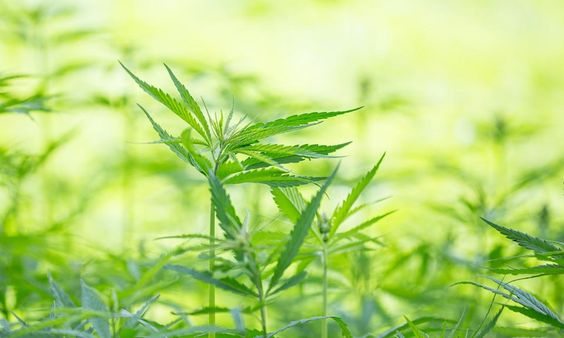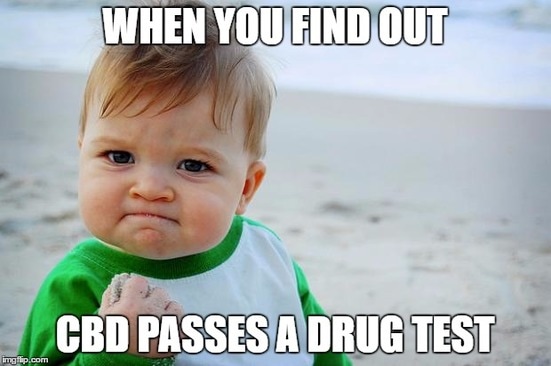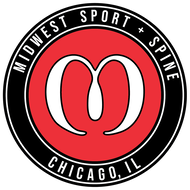Make CBD Great Again!By Dr Khong Lamvichit on 18 May 2017
What does Hemp and Marijuana have in common?! Well keep reading and you'll find out.
If you didn't already know, Hemp and Marijuana both contain a cannabinoid known as Tetrahydrocannabiniol (THC). This active compound is most well known for carrying psychoactive effects and getting you "high" when ingested or inhaled. I must include quantities are very little in hemp and the majority in Cannabis. The other cannabinoid this article is based on is the modern day rockstar, Cannabidiol, also known as CBD. This compound is a naturally occurring compound without the psychoactive effects like its THC counterpart. CBD has been widely used for it's vast medicinal properties throughout the world. History of Cannabis Cannabis (species: Cannabis sativa) is widely used as a recreational drug, with an estimated worldwide annual prevalence (defined as use at least once per year) of 160 million (7). Cannabis preparations have also been used medicinally for thousands of years. Dating back to 4000 BC, Cannabis sativa has a long history of medicinal use for the treatment of a variety of disorders such as rheumatism, chronic inflammation and pain management, in addition to control of convulsions (12). In the past 40 years the active ingredients of cannabis, Δ-9-tetrahydrocannabinol and cannabidiol, and other derivatives (termed “cannabinoids”) have been identified and characterized,(5) and it is becoming clear that cannabinoids have considerable therapeutic potential (6).
Consumption
To experience the full beneficial properties one can inhale, ingest, or apply. Inhalation is the most common; however ingestible oils and topical analgesics for pain have also been on the rise in recent months. CBD via inhalation termed an "old-style method" is still not obsolete. Inhalation of CBD can be consumed through Cannabis or vape pens. Typically these methods are for convenience. Ingestible CBD oils from Cannabis have won the hearts of many; however, is important to note ingestible oils contain a higher concentration of CBD and THC. Oils are normally taken as capsules on their own to aid with ingestion; although oils are also infused in edibles which make for a potent treat! Try Cannabis infused granola or quinoa salad or make your very own Cannabis butter! Notably due to the difficulty of proper dosing of oils, consumers may sometimes overestimate the doses. Application use of topicals are another effective method available to allow the healing benefits of CBD into your body. CBD clinic infuses the "Charlotte's Web" strain into their analgesic ointments. "Charlotte's Web" is a high cannabidiol, low tetrahydrocannabinol Cannabis extract developed by the Stanley brothers in Colorado. Endocannabinoid system CBD affects the endocannabinoid system (ECS). The ECS is a group of endogenous cannabinoid receptors located in the mammalian brain and throughout the central and peripheral nervous systems, consisting of neuromodulatory lipids and their receptors known as "the body’s cannabinoid system" (10). The ECS is involved in a variety of physiological processes including appetite, pain-sensation, mood, and memory, and in mediating the psychoactive effects of cannabis (11).
Treatment for Medical conditions Multiple Disorders CBD acts in some experimental models as an anti-inflammatory, anti-convulsant, anti-oxidant, anti-emetic, anxi-olytic, Alzheimers, and anti-psychotic agent, and is therefore a potential medicine for the treatment of neuroinflammation, epilepsy, oxidative injury, vomiting and nausea, anxiety and schizophrenia, respectively (9). Cannabidiol inhibits hyperphosphorylation of tau protein in Abeta-stimulated PC12 neuronal cells, which is one of the most representative hallmarks in Alzheimer's Disease (14). Inflammation These results suggest that the activated A(2A)AR in the retinal microglial cells plays a major anti-inflammatory role in the retina and that CBD's anti-inflammatory effects are linked to the inhibition of adenosine uptake (8). Cancer Proliferation In Canada, 4 cannabinoid products are currently available for medical use, more than in any other country worldwide(1). In Canada, dronabinol and nabilone are indicated for chemotherapy-induced nausea and vomiting, dronabinol is approved for HIV-associated anorexia, and oromucosal Δ-9-tetrahydrocannabinol–cannabidiol is conditionally approved for neuropathic pain in multiple sclerosis and cancer pain (1). Cannabinoids have been shown to specifically inhibit glioma growth as well as neutralize oncogenic processes such as angiogenesis (4). Chronic Pain Numerous randomized clinical trials have demonstrated safety and efficacy for Sativex in central and peripheral neuropathic pain, rheumatoid arthritis and cancer pain (3). Combinations of CBD and morphine produced synergistic effects in reversing acetic acid-stimulated stretching behavior in rodents (14). PTSD Repeated administration of CBD prevented long-lasting anxiogenic effects promoted by a single predator exposure in mice (2). Multiple Sclerosis The journal of European Neurology published an article concluding THC:CBD oromucosal spray provided symptomatic relief of MSS and related troublesome symptoms (15). A Pain medicine study suggest that Sativex may be effective in improving MS-related neuropathic pain, maybe through its action on specific cortical pathways (16). CBD administration at the time of viral infection exerts long-lasting effects, ameliorating motor deficits in the chronic phase of the disease in conjunction with reduced microglial activation and pro-inflammatory cytokine production. The findings highlighted the anti-inflammatory effects of CBD in the viral model of MS and demonstrate the significant therapeutic potential of this compound for the treatment of pathologies with an inflammatory component according to multiple authors of the Neurobiology Disease Journal (17).
Below are links for tinctures to begin your #CBDmovement and to your new road to recovery!
.Below are links to Amazon for hemp capsules, essential oils, and tinctures.
Below are topical analgesics with the infused Cannabis "Charlotte's Web" strain to help regain range of motion in the areas necessary for top level sport performance and Flexibility. A perfect pre- and post-workout solution for hours of relief. Helps to speed recovery for fatigued and painful joints and muscles. Ask your doctor or purchase these ointments at Midwest Sport and Spine.
References:
1. Wang, T., Collet, J., Shapiro, S., & Ware, M. A. (2008). Adverse effects of medical cannabinoids: a systematic review. Canadian Medical Association Journal,178(13), 1669-1678. doi:10.1503/cmaj.071178 2. Campos, A. C., Ferreira, F. R., & Guimarães, F. S. (2012). Cannabidiol blocks long-lasting behavioral consequences of predator threat stress: Possible involvement of 5HT1A receptors. Journal of Psychiatric Research,46(11), 1501-1510. doi:10.1016/j.jpsychires.2012.08.012 3. Russo, E. (2008). Cannabinoids in the management of difficult to treat pain. Therapeutics and Clinical Risk Management,Volume 4, 245-259. doi:10.2147/tcrm.s1928 4. Scott, K. A., Dalgleish, A. G., & Liu, W. M. (2014). The Combination of Cannabidiol and 9-Tetrahydrocannabinol Enhances the Anticancer Effects of Radiation in an Orthotopic Murine Glioma Model. Molecular Cancer Therapeutics,13(12), 2955-2967. doi:10.1158/1535-7163.mct-14-0402 5. Mechoulam R. The pharmacohistory of Cannabis sativa. In: Mechoulam R, editor. Cannabinoids as therapeutic agents. Boca Raton (FL): CRC Press; 1986. p. 1-19. 6. Beaulieu P, Ware M. Reassessment of the role of cannabinoids in the management of pain. Curr Opin Anaesthesiol 2007;20:473-7. 7. World drug report. New York: United Nations, Office on Drugs and Crime; 2007. 8. Liou, G. I., Auchampach, J. A., Hillard, C. J., Zhu, G., Yousufzai, B., Mian, S., . . . Khalifa, Y. (2008). Mediation of Cannabidiol Anti-inflammation in the Retina by Equilibrative Nucleoside Transporter and A2AAdenosine Receptor. Investigative Opthalmology & Visual Science,49(12), 5526. doi:10.1167/iovs.08-2196 9. Fernández-Ruiz, J., Sagredo, O., Pazos, M. R., García, C., Pertwee, R., Mechoulam, R., & Martínez-Orgado, J. (2013). Cannabidiol for neurodegenerative disorders: important new clinical applications for this phytocannabinoid? British Journal of Clinical Pharmacology,75(2), 323-333. doi:10.1111/j.1365-2125.2012.04341.x 10. Grotenhermen, Franjo (23 Jul 2012). "The Therapeutic Potential of Cannabis and Cannabinoids". Dtsch Arztebl Int. 109 (PMC3442177): 495–501. doi:10.3238/arztebl.2012.0495. PMC 3442177 11. Aizpurua-Olaizola, Oier; Elezgarai, Izaskun; Rico-Barrio, Irantzu; Zarandona, Iratxe; Etxebarria, Nestor; Usobiaga, Aresatz (2016). "Targeting the endocannabinoid system: future therapeutic strategies". Drug Discovery Today. doi:10.1016/j.drudis.2016.08.005. PMID 27554802. 12. Li, H.L. An archaeological and historical account of cannabis in China. Economic Botany. 1974; 28: 437–448 13. Iuvone, T., Esposito, G., Esposito, R., Santamaria, R., Rosa, M. D., & Izzo, A. A. (2004). Neuroprotective effect of cannabidiol, a non-psychoactive component from Cannabis sativa, on beta-amyloid-induced toxicity in PC12 cells. Journal of Neurochemistry,89(1), 134-141. doi:10.1111/j.1471-4159.2003.02327.x 14. Neelakantan, H., Tallarida, R. J., Tuma, R., Sara, J. W., & Walker, E. A. (2013). E.11 - Distinct Interactions Of Cannabidiol And Morphine In Three Nociceptive Behavioral Models In Mice. Behavioural Pharmacology,24. doi:10.1097/01.fbp.0000434830.93009.d7 15. Vermersch, P., & Trojano, M. (2016). Tetrahydrocannabinol:Cannabidiol Oromucosal Spray for Multiple Sclerosis-Related Resistant Spasticity in Daily Practice. European Neurology,76(5-6), 216-226. doi:10.1159/000449413 16. Russo, M., Naro, A., Leo, A., Sessa, E., D’Aleo, G., Bramanti, P., & Calabrò, R. S. (2016). Evaluating Sativex®in Neuropathic Pain Management: A Clinical and Neurophysiological Assessment in Multiple Sclerosis. Pain Medicine. doi:10.1093/pm/pnv080 17. Mecha, M., Feliú, A., Iñigo, P., Mestre, L., Carrillo-Salinas, F., & Guaza, C. (2013). Cannabidiol provides long-lasting protection against the deleterious effects of inflammation in a viral model of multiple sclerosis: A role for A2A receptors. Neurobiology of Disease,59, 141-150. doi:10.1016/j.nbd.2013.06.016
In addition to extensive fitness experience, having trained under reputable sports doctors in his field, Dr. Khong has been a long time Brazilian Jiu Jitsu, Boxing, and Muay Thai practitioner, most recently training independently in gymnastics, yoga, capoeira, and the Ido Portal method.
Dr. Khong also works professionally as a presenter and consultant for crossfit and powerlifting gyms throughout the Chicago Land area. Dr. Khong is originally from St. Petersburg, Florida and is a graduate of the Florida Gulf Coast University and National University of Health Sciences. Dr. Khong Lamvichit is a nationally board certified Chiropractic physician in Chicago, Illinois. |
Tweet What!Dr. Khong Lamvichit DCChiropractic, Physical Therapy, Nutrition, and good Sports Rehab all lead to one thing. Movement-Strength-Stabilization Archives
December 2024
Categories
|
Privacy Policy
Terms & Conditions
Merchant Agreement
Telemedicine Business Associate Agreement
Contact Us
Midwest Sport and Spine Inc., Chicago, IL
Phone (appointments): 312.397.1179
Phone & Fax (general inquiries): 312.397.1179 & 312.253.4453
Location: 434 W Ontario St, #310, Chicago, IL 60654
MSS TEAM
THERAPIES
LOCATION
COMMUNITY
MSS NEWSFEED
FAQ
PAY INVOICE
Copyright © 2022 Midwest Sport and Spine Inc. All Rights Reserved. Our Chiropractic Chicago Location







 RSS Feed
RSS Feed












